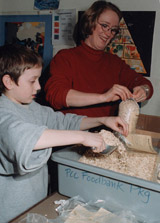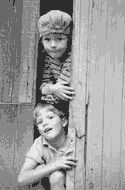Summer is a hungry time for many kids
This article was originally published in July 2001

See below: Web sites on hunger in America
Summertime can be a hungry time for children living at or below the poverty level. How is this possible, during the season of “abundance” when fresh food floods the markets in the “land of plenty?”
Consider that during the school year, 300,000 kids in Washington State eat free or reduced-priced school meals. When school is over for the summer, those meals end.
For low-income families, and families at or near the poverty level, this creates a hardship. They now must provide up to two additional meals a day for each of their children. More and more people are relying on food banks to recover those “lost” meals for their children during the summer.
Food banks came into existence in the late 1960s and originally were set up to provide food for emergency situations. Increasingly, food banks are called upon to provide monthly provisions — meeting an ongoing chronic need by families in our communities.
Hunger never takes a vacation
With children out of school, the demand on food banks is greatest during the summer. Ironically, it’s also a time when donations to food banks are at their lowest.
Many people donate money or food during the traditional “giving season” — winter holidays of Thanksgiving, Hanukkah and Christmas. While that’s a great time to give, those donations only last a couple months.
During the summer, people are busy outdoors, take vacation with their families or focus their attention elsewhere. People also just aren’t aware that demand at food banks is so great during the summer. Your reading this article is a beginning.
What can you do?
PCC offers a variety of ways to help the food banks. In our stores, at the registers, you can make cash donations which are used to purchase nutritious bulk foods for partner food banks. Simply tell the cashier how much you wish to donate and it will be added to your bill, which you can use for a tax receipt.
All PCC stores also have a bin at the front of the store for non-perishable food donations.
Want some other ideas? Once a month donate the amount it costs to take your child and a friend to lunch, say $10. Or, make a commitment to pick up one can of beans or jar of peanut butter each time you shop and deposit it in the bin at the front of the store. The difference each person can make is enormous.
For information about PCC’s Cash for the Hungry program, how to donate or volunteer, call 206-547-1222 or email . Or email
communityrelations@pccmarkets.com
One hundred percent of your donation — cash or non-perishable food items — goes to one of these food banks:
- Hopelink/Kirkland Food Bank
- Jewish Family Service
- West Seattle Food Bank
- University District Food Bank
- FamilyWorks Food Bank
- VOA Greenwood Food Bank
- Issaquah Food Bank
PCC pays all administrative costs.
Look for the large signs in stores showing cash donations made by shoppers during 2000. A big thanks to Cascade Signs for donating materials to make these signs possible. Another huge thanks to Mt. People’s Northwest for their continued partnership in PCC’s Cash for the Hungry program.
There are many wonderful organizations combating hunger. Check below for some of the resources available.
Consider these hunger facts
- Children represent the largest group going hungry in this country. More than four million children under age 12 go hungry each month.
- One in four children in Washington State is hungry, or at risk of being hungry.
- Children make up 42 percent of the clients served by food banks. In addition, 14 percent are seniors and 25 percent have disabilities.
- 73 percent of the “official” poor children live with at least one working parent. The majority of children receiving food from food banks have at least one working parent in the household, but they’re hungry or at risk for hunger because their family still lacks the money to buy enough food.
Web sites and contacts on children and hunger, and hunger in America
Summer Food Program – Find out if there’s a Summer Food Program near you: 1-800-201-3964.

Children’s Alliance – statewide, member based advocacy organization dedicated to improving the safety, security, health and education of Washington’s children: 206-324-0340, www.childrensalliance.org.
Food Resources/Fremont Public Association – Provides referrals to food banks, meal programs, and has a multitude of other networking and social services programs: 206-694-6700, www.fremontpublic.org.
The Emergency Feeding Program – provides food to those in emergency situations, including those with special dietary needs: 206-723-0647.
America’s Second Harvest – the largest hunger relief charity in America: www.secondharvest.org.
Center on Hunger and Poverty – www.centeronhunger.org.
Food Lifeline – the largest non-profit supplier to hunger relief programs in Washington State: 206-545-6600, www.foodlifeline.org.
Northwest Harvest – http://northwestharvest.org.
The Casey Foundation (produces the “Kids Count” survey annually) – www.aecf.org
The Food Research & Action Center (FRAC) – www.frac.org
The Hunger Site (donate to hunger relief organizations) – www.thehungersite.com
Tufts University nutrition site – http://nutrition.tufts.edu
USDA Food & Nutrition Service (info on food stamps and other nutrition programs): www.fns.usda.gov
USDA “Prevalance of Food Insecurity and Hunger, by State, 1996-1998” report – www.ers.usda.gov/publications/FANRR2/
Web sites compiled by Bob Cooper of Food Lifeline.
